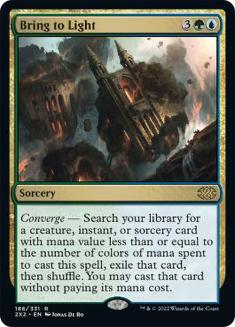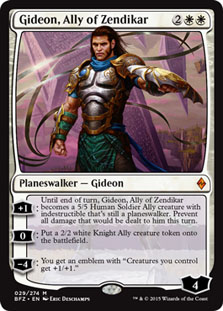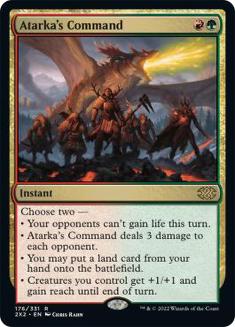Picking the right Standard deck in the early weeks after a new set’s release can be challenging. This is especially true when a set is rotating out and exciting new untested cards are flooding in. But it can be overwhelming and difficult to figure out what works and what doesn’t.
Today I’ll share my process when it comes to deck selection, be it building from scratch or tuning an existing deck. I’ll keep the ideas and lessons general so they can apply to every format while using examples from the current Standard format. These are some basic guidelines, steps, and questions you can use that will help you pick a winning deck.
Step One – Gathering Information
What information is available? This can vary pretty drastically depending on how long the set has been out for. Battle for Zendikar has had a little time to breathe now, but at certain points in time the information you have available can vary between seeing half a spoiler, to all the top-performing Pro Tour Decks, to decks hardened by months of grinding from Magic Online. Articles, tournament results, talking to teammates, testing, and your own thoughts about what cards are good also contribute to form a picture of what the best deck is.
The Open Series is one of the best ways to make your mark on a new format and one of the best resources for examining new lists.
Currently there have been Open Series events in Indianapolis and Atlanta that have provided the groundwork for Battle for Zendikar Standard going into the Pro Tour. Poring over these lists and thinking about the specific card choices in each deck is an excellent way to get ideas.
Magic Online and the results from Daily Events is another great resource.
There is also broader information that might be useful to know. Mono-Red won the last two Pro Tours? Maybe aggro is a good place to be lately in Magic.
Gathering information about a format is usually the first step to breaking a format and happens the most before and right after new cards are released, but it’s also an ongoing process. Staying up to date on what decks are performing well will help inform your decision. Knowledge is power!
Step Two – Brewing
Next up is actually applying your ideas and making a deck. Basically all decks made at the beginning of a format are going to be “brews” even when they’re based around old cards and strategies. I like to build updated versions of decks that can survive rotation and then focus on new cards and strategies that are accentuated by the new cards.




Focusing on a specific powerful card can be helpful when you’re making a new deck. This can help guide the direction of the deck and make you think about why your deck works at its core. What is the deck doing? Are the cards working together to accomplish that? Are they going to match up well against the other cards in the format?
For example, take Gideon, Ally of Zendikar, one of the most powerful cards in Battle for Zendikar. What happens when you try and find the best home for him? Gideon, Ally of Zendikar is an aggressive ground pounder that plays best when he isn’t being threatened by opposing creatures. He pairs very nicely with the G/W Megamorph shell, which is a deck that doesn’t lose much. Michael Majors made this connection and now G/W Megamorph appears to be a powerful force in Standard.
So what about a completely new brew? You need power and synergy. You’re aiming for the established decks or just trying to build a proactive and powerful deck. Don’t be afraid to play a brew if it holds up in testing. As soon as a brew is beating the best decks in the format it’s no longer a brew, it’s the best deck.
Step Three – Testing
Everything gets more important the closer it is to the tournament you’re playing in. New decks and innovations are discovered weekly. The most important playtesting is done when you have some proven tournament decks that make up a gauntlet and the gauntlet gets more powerful every day.
Still, playing games is important at any point in testing and is the best way to get a feel for the format and the card interactions. These can help shape your ideas for what works; if you’re losing to fliers or five-toughness creatures, your mind will start looking for solutions to those specific problems.
Just a few games are often all you need to get a feel for what beats what. Try the top decks against each other. Is there a clear winner or more of a rock-paper-scissors effect? Is one deck amazing except it keeps losing to a specific matchup? Can that matchup be improved at all or flipped after sideboard?
Step Four – Metagaming
Predicting what decks will show up to a tournament is very important so you can bring a deck that beats those decks. To be prepared is to be one step ahead of the rest of the field. A good place to start is by thinking about what deck beats last week’s best deck… many people will often bring the best-performing deck from recent tournaments. Remember you want to be one step ahead, it’s easy to go down the rabbit hole of playing a deck that beats the decks that beat the decks that beat… and so on and so forth until you have a mess.
Other formats might turn into something along the lines of Aggro beats Control, Control beats Midrange, Midrange beats Aggro, and you can expect a good mix of all those decks. In these situations a generally powerful deck that has the potential to beat everything is a good choice.
Of course the holy grail of deckbuilding is having a ridiculously powerful brew you’ve built and you’re just clenching hoping no one else discovers it or has the tools to beat it.
Step Five – Tuning
There’s no shame in netdecking. Whenever I’ve copied a decklist I think is great, I always change the deck. Not just to be a special snowflake – if I thought a decklist was perfect I would copy it without changing a card – I’ve just never come across a deck I haven’t wanted to alter a little.
Do you often watch movies and regularly feel the characters are acting in irrational ways, or a scene could be rewritten with a better joke? You can still enjoy a movie and still think parts of it could be improved. The same goes with a deck of Magic cards, but here you actually get to make those changes.
I really enjoy taking a great list and making it my own. I’ve played modified Open Series decks to success. For example, I took Kevin Jones’s Jeskai list:
Creatures (11)
Planeswalkers (3)
Lands (24)
Spells (22)

and built this:
Creatures (9)
Planeswalkers (2)
Lands (25)
Spells (24)

I took Ray Tautic’s Rally the Ancestors deck:
Creatures (32)
- 2 Nantuko Husk
- 2 Fleshbag Marauder
- 4 Elvish Mystic
- 3 Mogis's Marauder
- 4 Satyr Wayfinder
- 3 Grim Haruspex
- 3 Merciless Executioner
- 3 Den Protector
- 4 Deathmist Raptor
- 4 Liliana, Heretical Healer
Lands (20)
Spells (8)

and built this:
Creatures (31)
- 3 Nantuko Husk
- 3 Fleshbag Marauder
- 4 Elvish Visionary
- 2 Elvish Mystic
- 3 Sylvan Caryatid
- 2 Mogis's Marauder
- 4 Satyr Wayfinder
- 4 Grim Haruspex
- 2 Merciless Executioner
- 4 Liliana, Heretical Healer
Lands (21)
Spells (8)

Put your own ideas into action and make it your own, you’ll become a better deckbuilder for it. Or play someone’s exact 75 and learn from it. There’s nothing wrong with that either.
It’s easy to sling words, it’s much harder to sling cards. You get to express yourself and put your ideas to the test.
Step Six – Practice
I consider this a little different from testing, though testing is still good practice. Specifically, practice is for when you know what deck you’re playing and just need to get experience against the format as a whole or practice specific matchups while you prepare to face the unexpected in a tournament setting.
Can you see when your opponent is holding up Dromoka’s Command? What should you do when you both have removal? How hard should you play around sweepers? Guessing what’s in an opponent’s deck and knowing how to play against it can be just as important as knowing your own.
Can you competently pilot the deck you’re selecting? Did you leave enough time to learn it? Sometimes when it’s getting close to crunch time you just have to select a deck and learn how to play it even if you’re not certain it’s the best deck. Otherwise you might spend all your time picking the perfect deck and realize you can’t actually play it well.
The play’s the thing. The most important thing. Playing a medium deck perfectly is better than playing a great deck poorly. Trying to find the best deck is overrated. You lose a lot of games because you misplay, but you lose far fewer because you didn’t swap out that 75th card for a slightly better one. Improving your play is probably the biggest edge you can get. Everyone generally has a decent deck full of good cards.
I’m certainly guilty of fretting over four different decks when all of them would be fine choices, just wasting time that I could have spent mastering and tuning a specific deck.
Play a good deck and play it well. Having the discipline to mulligan that bad two-lander and read what’s in your opponents hand is a recipe for success.
Step Seven – Letting Go
I win, I lose, I win again.
There is no such thing as the perfect deck. Try as hard as you might, there will still be unanswered questions and risks associated with picking up any deck.
“What if?” is a question you might ask yourself after picking a deck.
What if everyone shows up with an amazing deck that I completely missed? What if everyone shows up with my worst matchup? What if I had picked a different deck?
This is not a useful question.
Magic is hectic, it’s messy, and anything can happen. Embracing the chaotic and random side is necessary in order to avoid going insane.
It is, of course, our duty as Magic players to try and crush every burgeoning format as best we can, but no deck is unstoppable. Don’t lose sleep over your deck choice, especially the night before a tournament.
Make the best choice you can and drop the worries. Let it happen.
Now if you’ll excuse me, it’s time to pick a deck for the Pro Tour.

